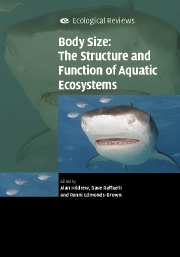Book contents
- Frontmatter
- Contents
- List of contributors
- Preface
- 1 The metabolic theory of ecology and the role of body size in marine and freshwater ecosystems
- 2 Body size and suspension feeding
- 3 Life histories and body size
- 4 Relationship between biomass turnover and body size for stream communities
- 5 Body size in streams: macroinvertebrate community size composition along natural and human-induced environmental gradients
- 6 Body size and predatory interactions in freshwaters: scaling from individuals to communities
- 7 Body size and trophic cascades in lakes
- 8 Body size and scale invariance: multifractals in invertebrate communities
- 9 Body size and biogeography
- 10 By wind, wings or water: body size, dispersal and range size in aquatic invertebrates
- 11 Body size and diversity in marine systems
- 12 Interplay between individual growth and population feedbacks shapes body-size distributions
- 13 The consequences of body size in model microbial ecosystems
- 14 Body size, exploitation and conservation of marine organisms
- 15 How body size mediates the role of animals in nutrient cycling in aquatic ecosystems
- 16 Body sizes in food chains of animal predators and parasites
- 17 Body size in aquatic ecology: important, but not the whole story
- Index
- References
8 - Body size and scale invariance: multifractals in invertebrate communities
Published online by Cambridge University Press: 02 December 2009
- Frontmatter
- Contents
- List of contributors
- Preface
- 1 The metabolic theory of ecology and the role of body size in marine and freshwater ecosystems
- 2 Body size and suspension feeding
- 3 Life histories and body size
- 4 Relationship between biomass turnover and body size for stream communities
- 5 Body size in streams: macroinvertebrate community size composition along natural and human-induced environmental gradients
- 6 Body size and predatory interactions in freshwaters: scaling from individuals to communities
- 7 Body size and trophic cascades in lakes
- 8 Body size and scale invariance: multifractals in invertebrate communities
- 9 Body size and biogeography
- 10 By wind, wings or water: body size, dispersal and range size in aquatic invertebrates
- 11 Body size and diversity in marine systems
- 12 Interplay between individual growth and population feedbacks shapes body-size distributions
- 13 The consequences of body size in model microbial ecosystems
- 14 Body size, exploitation and conservation of marine organisms
- 15 How body size mediates the role of animals in nutrient cycling in aquatic ecosystems
- 16 Body sizes in food chains of animal predators and parasites
- 17 Body size in aquatic ecology: important, but not the whole story
- Index
- References
Summary
Introduction
As ecologists seek conceptual syntheses to understand the mechanistic and functional processes that underlie empirical community patterns in different ecosystems, they are developing concepts that depict complexity on a number of universal themes. General patterns in the statistical distributions of species and individuals within and across ecosystems provide information about the organizing principles underlying ecosystem structure. Interrelations between species richness, population density, body-size and distribution ranges are of central concern in ecology and have been widely debated (Brown, 1995; Brown, Allen & Gillooly, this volume). To represent the structure of ecosystems adequately, species composition and population size are the most appropriate attributes containing information that is closely correlated with the organism's size.
Attributes of body size may affect many ecological characteristics, such as resource use and allocation in communities, reflecting their complex internal structure. Feeding patterns that result in resource partitioning among species of a benthic species assemblage demonstrate strong body-size dependence (Schmid & Schmid-Araya, 1997; Woodward & Warren, this volume). Information on species population and body-size distribution (BSD) of communities is frequently given for the larger or is toxonomically not well resolved, organisms inhabiting an ecosystem, therefore resulting in veiled, often highly scattered and incomplete, distributions. In contrast, the size distribution of well-resolved species communities may reflect the different evolutionary traits underlying diverse scaling domains. Therefore, more realistic expectations for real-world species and abundance distributions are obtained using scale-dependent definitions of individual species' spatial and/or size structure within communities.
- Type
- Chapter
- Information
- Body Size: The Structure and Function of Aquatic Ecosystems , pp. 140 - 166Publisher: Cambridge University PressPrint publication year: 2007
References
- 3
- Cited by



